Protagonists: Kratos | Atreus
Greek Era: Gods (Zeus) | Titans | Mythology's Heroes | Other Beings | Normal Humans | Characters from Comics
Norse Era: Gods (Odin | Thor | Mimir | Baldur | Heimdall | Freya) | Jotnar | Other Characters (Sindri and Brok) | Monsters
All miscellaneous beings from Greek mythology (plus a handful of Egyptian and Persian), that are neither Gods nor Titans. Most of them are monsters that serve as enemies or bosses.
Primordials


- Cosmic Entity: They are the embodiment of the primordial natural elements, such as the sky, ocean, or landmasses. Despite their primordial nature, their appearance is humanoid, resembling the one of human beings or deities.
- Continuity Snarl: They are stated to have created the Earth, however the Norse era games state that the world was created from the corpse of Ymir by Odin. Most likely they are referring to their respective lands and not the entire planet.
- Creation Myth: The cosmic war which the Primordials waged against one another shaped the natural elements of the world. The ocean, for example, was formed when Ceto, embodiment of the sea, was destroyed by Uranus, embodiment of the sky.
- Humanoid Abomination: Despite being the embodiment of primordial natural elements, they appear as giant humanoids, completely nude with the exception of a war helmet.
Sisters of Fate
- Bad Boss: They allowed Theseus to die because they underestimated Kratos.
- Because Destiny Says So: Since they control the fates of every living being on existence, even the Olympians, nobody can go up against their edict. Subverted when Kratos decided to stand up to their authority and challenged them at their refusal of granting him control over the Threads of Fate. A long battle followed, at the end of which Kratos defeated and brutally killed the three Sisters of Fate. By destroying the deities who personified fate, Kratos was effectively able to change his own destiny.
- Did You Just Punch Out Cthulhu?: The Sisters of Fate are some of the most powerful creatures of the in game universe, being capable of controlling the destiny of both mortals and deities. Despite this, when they refuse to grant Kratos control over his own destiny, he decides he will take it by force killing the Fates themselves. After a brutal fight, he manages to trap two of the Sisters in a dimensional mirror and then shatters it, erasing them both from existence, and then kills the last one by impaling her skull with a giant blade.
- Dragon-in-Chief: Played with. While Zeus is definitely powerful on his own right and serves as Final Boss in the second game, it's said that the Sisters are even more powerful than him and their word is unquestioned and final - after all, it was them who decreed that the Titans would lose the war against the Olympians - it just so happens that their laws benefit Olympus (mostly). It's with their defeat that Kratos has a chance at confronting Zeus while he is at his most vulnerable.
- Humanoid Abomination: They are neither gods or titans, but something far older than both.
- It Amused Me: It turns out, they never intended to let Kratos, or anyone else for that matter, change their destiny. Watching so many mortals and demigods go through the trials only to be killed horribly along the way makes them laugh.
- Magic Mirror: How they manipulate fate, so they can see exactly what they are manipulating.
- Time Master: They control time.

The middle Sister of Fate who determines the destinies of Gods and mortals alike.
- Animal Motifs: Seems to model herself after a bird, as evidenced by her clothes, ability to fly and actually having a phoenix.
- Badass Boast: One that cements her belief in her own superiority and that destiny cannot be altered.Lahkesis: You have always amused us, Kratos. But know this, mortal. There is no power greater than the Sisters of Fate. If you challenge us, You... Will... Die!
- Boom Stick: She can fire projectiles with her staff.
- Cessation of Existence: After a brutal fight, Kratos traps her and Atropos in a multi dimensional mirror and shatters it, erasing them both from existence.
- Foreshadowing: When Kratos breaks her statue, there's another one inside like a Russian doll. Later, it's revealed that Atropos inhabits Lahkesis' body.
- Humanoid Abomination: Despite her human-like (and even attractive) shape, she's not remotely human.
- Lady of War: She is a powerful and elegant deity who fights gracefully using both magical and physical attacks.
- Nice Job Fixing It, Villain: She gloats to Kratos that he only progressed as far as he did because she allowed him to, something which her sister Clotho warned her against. This turned out to be a bad idea...
- Sexy Slit Dress: Her skirt has slits on both sides that go all the way up to her butt.
- Stripperific: Her outfit exposes her left breast.
- Tennis Boss: She'll send balls of energy at you, so use the Golden Fleece to reflect those projectiles right back at her.
- Villainous Breakdown: She goes from cool and arrogant upon meeting Kratos to increasingly more nervous during their boss fight and outright goes into This Cannot Be! mode when he traps Atropos in the past.
- Voice of the Legion: When Atropos was inside her body.

The oldest Sister of Fate who severs mortals' threads of life, which indicates their deaths.
- Ax-Crazy: Much more enthusiastic about killing Kratos than her sisters.
- Badass Boast: She boasts of her power over destiny with a small demonstration and a large threat. She brings Kratos back to the final boss of the last game and describes how she'll ensure Kratos will lose this battle with her meddling.
- Bling of War: Her corset and hairdress are golden.
- Cessation of Existence: Kratos traps her and Lahkesis in a mirror, then shatters it, erasing them both from existence.
- Evil Laugh: Lets out a few cackles as she revels in your eventual demise.
- Femme Fatalons: In reference to her role in mythology, this attractive naked women has claws she can use to shatter steel.
- Flunky Boss: She summons a legion of undead to distract Kratos while she attempts to ruin his past.
- Girlish Pigtails: Averted. She isn't even a bit girlish. She's not even the younger sister.
- Humanoid Abomination: Like Lakhesis, she's more or less humanoid. However, it's even more obvious in Atropos' case that she isn't remotely human.
- Living Shadow: Her lower half is just a trail of black smoke.
- Make Wrong What Once Went Right: Her boss fight is on a timer, because if she can destroy the Blade of the Gods, Kratos won't have defeated Ares and his current self fighting her will be erased from existence.Atropos: We control your destiny, foolish mortal! With a whim, we can end your life! Or allow you to live. Search your memory, Kratos. The sword which you stand on delivered your victory against Ares. Without it, you will be the one who dies this day. Not Ares! We can change your past and set your future! This is the power of the Fates!

The youngest Sister of Fate who spins the threads of life for Gods and mortals.
- Adaptational Ugliness: In the original mythology, Clotho was stated to be the most beautiful of the Sisters of Fate. Here, she's a fat and ugly silkworm-like monster.
- Animal Motifs: She resembles a giant silkworm.
- Big Little Sister: Despite being the youngest, Clotho towers over her sisters by several storeys.
- Eldritch Abomination: Unlike her sisters, Clothos can't be called "humanoid" by any stretch of the imagination.
- Fan Disservice: You climb platforms around her naked body. Her hideous, fat, purple naked body with more breasts than Mother Nature intended.
- Fat Bitch: One of the nastier Sisters, as well as hideously obese.
- Irony: In the Greek myths, she was called the most beautiful Sister of Fate. Here in the game, well...
- Impaled with Extreme Prejudice: Kratos kills her by impaling her skull with one of the pendulum of the Loom Chamber.
- Multi-Armed and Dangerous: She tries to swat you like a fly as you progress around her.
- Only Sane Man: She seems to be the only sister who was against Lahkesis' decision to let Kratos waltz into their palace and the only one who seems to be actually concerned about the world if Kratos wins. After Kratos had killed her two sisters, she still tried to warn him to not proceed further and not to tamper with the threads of life. Kratos completely ignored Clotho's warnings, and proceed to brutally kill her instead.
- Stone Wall: So massive that she can't even move.
The Furies
- Blue-and-Orange Morality: One of the notes from the Scribe of Hecatonchires states that the Furies "follow their own view of right and wrong."
- Doomed by Canon: Not surprising, given that they're the main antagonists in a prequel.
- Face–Heel Turn: While its a stretch to call them "good" due to their Blue-and-Orange Morality, Orkos said they used to be more fair before Ares came along and corrupted them, turning them into the more cruel beings we see in the game.
- Foil: To the Sisters of Fate in II. Both are Primordial beings older than both gods and titans and are also subservient to Olympus and they even resemble each other closely: Lachesis and Alecto being the leader and the most humanoid of them all, Atropos and Tisiphone being the most cruel, and Clotho and Megaera being the most inhuman with multiple limbs. The key difference is that the Fates are loyal to Zeus, while the Furies are loyal to Ares and are secretly aiding him to overthrow his father.
- Lawful Stupid: All of them are ridiculously obsessed in imposing blood oaths, regardless of the morality of breaking them or their own survival. Subverted, the real reason they are enforcing Kratos' oath to Ares is because they are working with Ares to bring down Olympus, and Kratos is a crucial part of the plan.
- Master of Illusion: They all use illusions to try and break Kratos's will.
- Time Abyss: They predate even the Titans.
- Villain Ball: They have successfully captured Kratos and confiscate all the relics he has obtained through the course of his journey. However, rather than destroying those items or hide them somewhere secure such as the Statue of Apollo, they chose to keep it within their pockets, allowing Kratos to retrieve them back and ultimately lead to their downfall.
- Villainous Crush: Implied. Alecto says to Kratos that should he continue to serve Ares, they would grant him the pleasant illusion of being with his wife and daughter again, with them posing as his wife. Naturally, Kratos refuses.
Megaera

The Fury of Jealousy.
- Body Horror: She spawns her Puppeteer Parasites from some nasty-looking rash on her chest.
- Climax Boss: Chronologically and gameplay wise, she serves as the penultimate boss of Ascension.
- Handicapped Badass: Lost her right arm in a previous fight with Kratos.
- It's Personal: Unlike her sisters, who merely see taking on Kratos as a duty, she wants revenge for him taking her arm.
- Fan Disservice: Megaera's cleavage is very open and has some disgusting rash where her parasites spawn from.
- Lovecraftian Superpower: Her ability to spawn parasites to infect other living beings and turns them into monsters is unlike anything seen in Greek myths and more in line with a H.P. Lovecraft story.
- Nice Job Fixing It, Villain: While beating up Kratos, she inadvertently broke some of the chains that were keeping him prisoner and helped him escape.
- Spider Limbs: That protrude from her back and she uses them to move quickly across Aegeon and the prison, as well as form a way to attack.
- Starter Villain: Chronologically, she is the first being killed of the immortals Kratos fights. Her Boss Battle is in the tutorial, in the earliest game. The majority of the game tells How We Got Here.
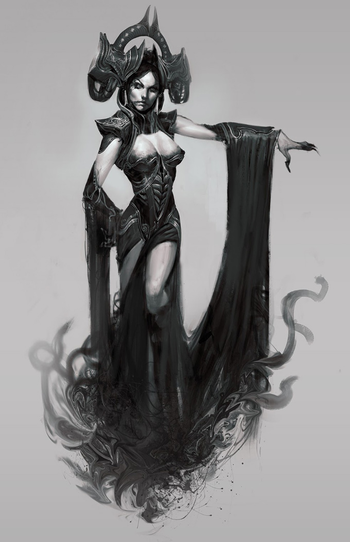
The Fury of Anger.
- Abusive Parent: To Orkos when he wasn't born the powerful warrior she and Ares desired.
- All for Nothing: Taunts Kratos with the fact that slaying the Furies will do nothing to undo or save him from the sins of his past.Alecto: My death will not free you from this madness!
- Arc Villain: Of Ascension.
- Body Horror: Not as bad as Megaera, but when she transforms into her sea monster form, her body begins to secrete black ink-like ooze in messy spurts with disgusting squelching sounds, all while she writhes on the floor and laughs. Her legs fuse together into a long tail and two spiked tentacles emerge from her waist, all while her voice lowers down several octaves. And while all this is going on, Alecto is now giving off so much sludge from her upper body that one can barely even see what she is turning into.
- Combat Tentacles: Has six giant ones lined with spikes when in her sea monster form, big enough to grip and toss ships through the air. Kratos blasts one of them off with an explosive stab, leaving her with only five for the final phase.
- Dark Is Evil: There's some tar-like dark matter sliding across her skin, and she's the most evil of the Furies.
- Defeat Equals Explosion: When she is killed by Kratos, her body turns into a mass of black goo which quickly disintegrate into nothingness.
- Evil Laugh: Lets out a distorted one as she twists and melts into her tentacled monster form.
- Eye Scream: Monster Alecto has her left eye stabbed by Kratos at the climax of their fight. Oddly enough, the wound doesn't carry over to her normal form one she transforms back, though she is still heavily weakened.
- Final Boss: Pairs with Tisiphone as the final boss of Ascension.
- Lotus-Eater Machine: She offers Kratos the option to live out his life in one of these, reunited with his family, in exchange for renewing his loyalty to Ares and assisting in the plan to overthrow Zeus. Kratos, much to Alecto's fury, rebuffs her.Alecto: If this is what keeps you in service to Lord Ares, then this is what you shall have.Kratos: It is not real!Alecto: ( taking the form of Kratos' wife) I can be your reality. (returns to her true form) The hard part is over, Spartan. You have committed the ultimate sacrifice. Offer yourself to us completely, and you shall live in blissful illusion.Kratos: Never!Alecto: (furious) Then let death be your reality!
- One-Winged Angel: Turns into a giant Kraken-like monster during the final boss battle. This form is often confused with Charybdis, which apparently was going to be a separate boss at first, but there's nothing in the game to confirm the relation between the two.
- Scary Teeth: Instead of a beak for a mouth like a squid or octopus, Alecto's Kraken-like form has a cluster of curved fangs that jut out of her upper jaw.
- Shapeshifter Guilt Trip: Briefly takes on the form of Kratos' wife Lysandra when he has the upper hand. Kratos hesitates for a brief moment before brushing it off and continuing his assault.
- Tentacled Terror: Her giant sea monster form. It's so large that she was able to drag down the broken Statue of Apollo into the sea to keep Kratos from reaching the Lantern of Delos within.
- We Can Rule Together: While all the Furies were in cahoots with Ares's plan to overthrow Zeus and claim Olympus, Alecto was Ares's mistress and thus would've had the most to gain from such a plan.
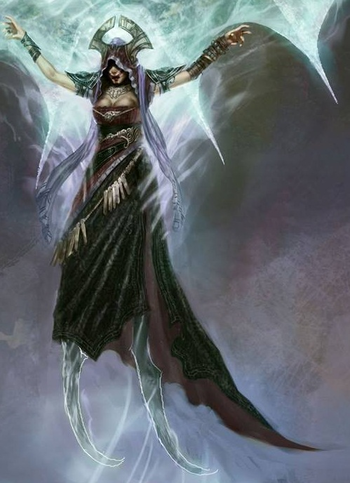
The Fury of Vengeance.
- Armed Legs: As seen in the example picture of her, Tisiphone can cover her legs with illusion magic in the form of curved hooks to make her swooping kicks more dangerous.
- Defiant to the End: Her last act before being killed is to take the form of the oracle of the temple where Kratos massacred his family and taunt him over the murders one last time.
- Dual Boss: Pairs up with both Megaera and Alecto as both the penultimate and Final Boss of Ascension.
- Familiar: Daimon, a skeletal bird of fire that helps her fly, acts as her primary combat method, and appears to be made of illusions.
- Guardian Entity: Tisiphone fights with a monster-bird called Daimon which can move her around, attack on her behalf or turn into multicolor fire to attack from above. When Kratos dispels Daimon, Tisiphone is seemingly in great pain, becoming vulnerable to Kratos' finishing attack.
- Honey Trap: Conjures an entire illusory harem of topless, bisexual beauties to seduce and kill Kratos, but fails when he sees through her ploy.
- In the Hood: She wears a black hood with ornamental horns.
- Logical Weakness: Not herself particularly, but Daimon. While the Eyes of Truth typically allow Kratos to stun enemies and dispel the illusions cast by the Furies, he ends up using them as a makeshift weapon to beat Daimon into submission when it tries to protect her from being finished off in the climax. Kratos then forces the mask-like trinket onto Daimon's face as it tries to get up, the beast exploding into light as soon as it make contact.
- Master of Illusion: She makes illusions so good they're almost indistinguishable from reality, and even her familiar Daimon seems to be a solid illusion.
- Ms. Fanservice: Tisiphone assumes the form of a topless concubine to seduce Kratos and presumably lead him to his doom. Otherwise, her default appearance is just as sinister as her sisters.
- Neck Snap: Receives one following her No-Holds-Barred Beatdown.
- No-Holds-Barred Beatdown: Is on the receiving end of one by Kratos at the end of the game.
- Spotting the Thread: Kratos is able to see through her illusion because she is wearing Lysandra's ring. Before that, he needed to find an artifact to see through her mirages.
- Technicolor Fire: Through Daimon she can summon rainbow-colored fire to attack.

The deity of oaths. He is the son of Ares and the Furies, as an attempt to create "the perfect warrior". Born "weak", he was rejected by his father, but accepted by his mothers and given his position, which he served diligently until he saw the injustice in Kratos' oath.
- Abusive Parents: While not actively abusive, Ares conceived him with Alecto with the sole intent of creating a perfect warrior to support his Evil Plan to overthrow Olympus, only to disown him when Orkos turned out to be a disappointment. Likewise, the Furies manipulated him into aiding their work in punishing traitors and oathbreakers, only to imprison and presumably torture him when he turned on them to help Kratos.
- Body Horror: Has several open, gaping wounds on his chest
- Dark Is Not Evil: He acts as a guide to Kratos, eventually earning his respect, despite looking like a pitch-black person with glowing orange wounds all over his body.
- Defector from Decadence: He turned on the Furies when he realized just how unjust Kratos' oath to Ares was.
- Deuteragonist: Replaces Athena as Kratos's guide in Ascension.
- Face Death with Dignity: He gives Kratos his sword, tells him to give him an honorable death, and calmly awaits his fate.
- Heroic Sacrifice: He has Kratos kill him in order to fully sever his bond to Ares.
- Irony: In mythology, Orkos is actually just an aspect of Hades as the god of oaths. Now, Hades is often stated to be the father of the Furies. That role is switched here.
- Nice Job Breaking It, Hero: He helped Kratos break free from Ares and the Furies to stop them from destroying Olympus. Years later, Kratos would do that on his own.
- Nonhuman Humanoid Hybrid: Half-Olympian, half-Fury.
- Token Good Teammate: He's the only Fury with any sense of morality and actually helps Kratos instead of fighting him.
- Too Good for This Sinful Earth: Just like Pandora, Orkos is a genuinely good person to the point where even Kratos truly considers him a friend. Of course, Kratos ends up forced to mercy kill him.
Monsters

- Action Bomb: The Fiends are female monsters that attack from a distance with either fiery embers or electrical bullets. If finished off by a normal attack they split in half and crawl towards Kratos to blow him up.
- Ancient Grome: Ancient Greece did not have "legions" or "legionnaires"; both of these terms come from the army of the Roman Republic and later Empire. Instead, Greek infantrymen were called Hoplites.
- Dark Action Girl: The Olympus and Hades Fiends are distinctively female and though rarer than most Legionnaires, they are more dangerous individually due to throwing explosive projectiles and blowing up upon being defeated (unless if they were finished).
- Dem Bones: One variant is a bare skeleton with only a shield and scimitar, similar to the ones in Jason and the Argonauts. They can also reform unless killed with a strong attack or a grapple.
- Elaborate Equals Effective: You start up with an half-naked wretch with a rusty sword and helmet, then Legionnaires gets additional armor, better swords, spikes on their equipment, occasional shields all the way to towering, surprisingly nimble warriors dual-wielding a sword and a scythe.
- The Goomba: Undead Legionnaires are at their most dangerous in huge groups, but can otherwise be dispatched with ease and are some of the only enemies in the series who can be killed with a single press of the circle button.
- Mooks: The most basic and numerous enemies you will find in any of the games, except for Ascension.
- Moveset Clone: In Ragnarok's Valhalla DLC, they partially reuse the moveset of the Draugr from the Norse Saga.
- Night of the Living Mooks: They were warriors that fell into battle, but were raised by the gods as empty husks to serve them.
- Our Zombies Are Different: A basic (and numerous) type of mook used as undead soldiers.
- Slave Mooks: Legionnaires in III are stated to be press-ganged dead civilians forced into servitude due to Olympus scraping the barrel for more manpower.
- Spikes of Villainy: The more barbs and spikes on the Legionnaire's armor and weapons, the stronger the Legionnaire is.
- Took a Level in Badass: In Valhalla, while they are still very much basic Mooks, they are not Cannon Fodder which can be slaughtered en masse by Kratos like in the Greek games and are more akin to basic humanoid units in the Norse games, requiring a fair bit of damage to take down but having a predictable moveset.
- Dual Wielding: In a rather flamboyant choice, Captains can be seen wielding a broadsword in their right hands and carrying a Sinister Scythe they can sometime use in tandem with their swords.
- Elite Mooks: Legionnaire Captains are not only tougher than normal legionnaires, but need two finishing moves to properly kill them.
- Glowing Eyelights of Undeath: Unlike basic Legionnaires, they have these to help denote their greater power.
- Rank Scales with Asskicking: Captains are much stronger than basic Legionnaire infantry grunts, to the point that they can't be instakilled with a grab and actually require two grabs to finish them off, as well as dealing significantly more damage. As such, they're encountered far more rarely.
- Sinister Scythe: They employ these alongside their main sword weapons to great effect, dealing out deadly and hard-to-avoid combos.

- Golem: They serve as giant, elementally-charged powerful enforcers made of stone or bronze.
- Living Statue: They usually pretend to be part of the scenery, and sometimes may awaken the second time you visit that area.
- Mechanical Monster: Implied to be the handiwork of Ephaestus.
- Smash Mook: No fancy moves, just cave your skull in while having enough resilience to endure your own attacks.
- Boss in Mook Clothing: The Titan Minotaurs in the second game are considered the toughest, most dangerous non-boss enemies, though only three are encountered in the whole game.
- Breath Weapon: Hades Minotaurs from 2 can breathe fire to light their clubs and make them fiery.
- Brutish Character, Brutish Weapon: They predominantly carry axes, hammers and clubs to reflect their status as Smash Mooks and bloodthirsty monsters.
- Cutscene Power to the Max: In their debut cutscene, a Grunt can throw an axe towards a enemy
- Dual Wielding: Minotaur Hammer Grunts are the same Grunts with an additional hammer on their back they can sometime use to perform a combo.
- Hoist by His Own Petard: In some cases, like Chain of Olympus or with the Hades Minotaurs, Kratos uses their own weapons to finish them off.
- Impaled with Extreme Prejudice: The standard finisher for most minotaurs consist in Kratos pinning the beast down and impaling it through the mouth. They also try to gore Kratos with their horns.
- A Kind of One: The original minotaur was a single individual monster killed by Theseus, while in the game they are an entire race with several variations.
- Magma Man: The third and final Titan Minotaur is found inside Atlas' body while submerged in lava and uses the environment to try and kill Kratos.
- Neck Snap: In III, Kratos can kill Elites and Labrys Minotaurs by grabbing their horns and snapping their necks.
- Non-Indicative Name: Labrys Minotaurs in the third game to not wield a traditional labrys axe but rather a fantasy battleaxe with concave blades and a massive bull head ornament taking up most of the body.
- Our Minotaurs Are Different: An entire race of monsters like these, unlike the original minotaur that was a single monster born from an unnatural union. Valhalla reveals that they were a race created by Ares to be his servants based off of the original Minotaur of Crete, which may or may not have been Pandora's Guardian from 1. The bulls look tend to look more and more grotesque as they grow stronger.
- Smash Mook: They primarily serve as this with incredibly hard-hitting attacks to compensate for their relatively slow movement, making them a priority target when they appear in encounters.
- Spikes of Villainy: Stronger breeds tend to have bone growths on their bodies or even extra horns.
- Underground Monkey: In the first game, all the Minotaurs, cosmetics and attack variations aside, are identical, while in the second game Erebus Minotaurs are like Grunts but covered in ice. Later games add more varations.
- Boss Tease: During the Challenge of Hades segment in Pandora's Temple, Kratos passes a huge set of locked doors. Later, in the end of the Challenge, these doors unlock and immediately something starts to hammer them from behind. After passing a Save Point and walking through a door that closes behind, it becomes obvious to the player that the room they're returning to is actually a Boss Room. When the player reaches the gate, the doors swing open and suddenly Pandora's Guardian emerges from behind them.
- Breath Weapon: It's capable of spewing out a stream of molten lava as one of its many attacks.
- Broken Armor Boss Battle: It's covered in nearly impenetrable armor which Kratos must remove by wearing the beast down and gradually weakening it using the room's ballista before knocking individual pieces of its armor off. Once the armor is removed, a final ballista shot is needed to finish it off.
- Damage-Sponge Boss: Because of how ludicrously armored it is, it can tank a staggering amount of damage without letting up. Once the armor is off, however, it's a different story.
- Fashionable Asymmetry: It has different spike patterns on both its shoulders and gauntlets which manage to not look out of place.
- Gate Guardian: It protects the large blocked door that the player will have already passed by at least once in the area containing the Challenge of Hades, and killing it is the only way to get past said door.
- Giant Space Flea from Nowhere: You are launched into a boss fight with it after completing the Challenge of Hades, with very little buildup or explanation for its existence.
- Glowing Eyelights of Undeath: Its eyes perpetually burn a bright reddish-orange, and it's some kind of minotaur Undead Abomination.
- Painting the Medium: Its health bar is just as armored as it is, and it's actual health bar will gradually begin to show through the cracks of the armored one as you damage the creature's armor.
- Impaled with Extreme Prejudice: Kratos finally kills it by firing a massive flaming ballista bolt into its chest and nailing it to the door behind it.
- Impossibly Graceful Giant: Despite being 20 feet tall and covered in heavy armor, it is a Lightning Bruiser capable of leaping off of the walls of its chamber into an extremely fast and powerful charging attack, which is more than a little physics-defying by the look of it.
- Lightning Bruiser: Its attacks are extremely fast for its size and it hits like a truck, especially on higher difficulties where it's capable of killing Kratos in just a handful of hits.
- King Mook: Pandora's Guardian is a much larger Minotaur than any other encountered in the series, dwarfing even the Titan Minotaurs from 2.
- The Spook: Unlike most of the other traps and denizens found within the Temple of Pandora, Pandora's Guardian is never given an explanation for existing. It can be assumed that it's one of the Temple's many challenges due to it guarding a door which a required key item is behind, but who created it or put it there is a total mystery.
- Stance System: It has two entirely different movesets depending on if Kratos fights it up on the platform where the ballista is or if he fights it down on on the lower floor. On the floor Pandora's Guardian is a relentless and deadly attacker, constantly throwing sequential attacks at Kratos which knock him backward, whereas on the platform its attacks are slower and easier to block but hurt much more if they connect.
- Undead Abomination: Removing its armor reveals it to be a gigantic minotaur corpse which is somehow still alive, and no explanation is given as to its origins.

- Arrogant Kung-Fu Guy: They have elements of this. Should they perform some successful grab on Kratos and throw him to the ground, they will stand in their weapons as a way to mock the Spartan warrior.
- Dance Battler: They have some wicked capoeira moves on them.
- Double Weapon: In the first two main games, the Satyr's weapon of choice is a long metal staff with hook-shaped blades on each end which they can separate into two weapons (and a variant in the second game use the separated staff by default), while in the third game they get a double spear with a hook on one end and a large glaive on the other.
- Elite Mooks: Satyrs have stood as the most formidable opponents in each iteration, able to go toe-to-toe with Kratos and make short work of him if the Spartan is not careful in battle.
- Fauns and Satyrs: They have goat-like traits with claws.
- Hoist by His Own Petard: Kratos usually dispatch them with their own double staves, cutting them in half or skewering them.
- Lightning Bruiser: Extremely agile and nimble and take even more hits to kill than the minotaurs, who are larger and bulkier.
- Mooks: In Ascension, smaller and shorter Satyrs are employed as "Lesser Satyrs" and serves as common enemies through the game, sometimes guided by a Captain. They're also more goat-like.

- Barbarian Tribe: Seem to have this aesthetic about them.
- Boss in Mook Clothing: They almost never flinch, love interrupting your combos while you fight smaller mooks (because they always come with smaller mooks), have a crapton of health, and the QTE when they grab you requires super-human reflexes to win. The finishing move on them is one of the squickiest of the game, but you won't mind
- Cruel and Unusual Death: In the first game, Kratos chops their front legs, impales them in the chest and after a brief desperate struggle slashes their throats. In the third game he manhandles them to the ground and graphically tears their stomach open.
- Elite Mook: In the third game, to the point that there are only three in the whole game and could be considered minibosses.
- Energy Bow: In the first game they wield bladed bows which can conjure energy strings.
- More Teeth than the Osmond Family: In the first game only, they had a collection of razor sharp teeth. Subsequent games dropped this design.
- Training the Peaceful Villagers: Kratos' writings in Valhalla reveals that not all Centaurs were savage, many were once peacful, concerned only with wine making and poetry but after taking up arms to protect their lands from invaders, the Centaur's found themselves headhunted for their skills in battle.
- Our Centaurs Are Different: In the first game, they have greenish skin for some reason and demonic faces, while they look more human in the third game.
- Attack of the 50-Foot Whatever: Polyphemus in Ascension is a humanoid Cyclops the size of a Titan.
- Bad with the Bone: Several variations wield huge jawbones as crude, improvised clubs.
- Beast of Battle: A short enemy type called Beast Lords can summon cyclopes with their horns and use them as destruction engines. Kratos and Olympic Fiends can also ride them in the third game.
- Carry a Big Stick: If they're not fighting with their bare fists, you can bet they'll be using a huge club of some kind, be it a mace, tree trunk, giant monster's jawbone or otherwise.
- Classical Cyclops: The classical man-eating one-eyed giants, portrayed as unintelligent and troll-like beings.
- Elaborate Equals Effective: Generally, the more spiky and elaborate the Cyclops' clothing (if it has any besides a loincloth) is, the tougher of a variant it'll be. This applies in full force to the Cyclops Desert Kings from 1, which are some of the strongest enemies in the entire game but are encountered very sporadically.
- Eye Scream: A common way to finish them off is for Kratos to rip out their single eye out of their heads. The second game even keeps a counter of the number of cyclopes' eyes you have taken.
- Giant Mook: Typically, the largest and strongest common enemies, barring the stronger minotaur variants.
- Go for the Eye: A very common finisher Kratos performs on them is to capitalize on their lack of multiple eyes by ripping out their single eye with a grapple, permanently blinding them and instantly killing them afterward.
- Groin Attack: In some finishers, Kratos opens the attack with one.
- Mighty Glacier: They are typically sluggish and have slow-moving and predictable attacks, but if those attacks connect they'll take huge chunks off of Kratos' health bar and send him flying. They also usually have a great deal of health to offset their high-priority status in fights.
- Sadly Mythtaken: Polyphemus is depicted as an uber-badass colossal Cyclops while he was one of the lesser ones, and got nothing on the original three Cyclopes (Bronte, Steropes and Arges).
- Smash Mook: They have powerful and relentless attacks, making them a high priority target to defeat immediately.
- Spikes of Villainy: Cyclops Enforcers wear armor covered in spikes and have huge flails in lieu of their right hand.
- Tragic Villain: Valhalla and the memories conjured up to combat Kratos in the titular realm would explain much more about why they were an enemy in the original saga as a codex entry; the Cyclopses were originally simple farmers located on islands throughout the Mediterranean content with living in their quiet peace despite their frightening appearance and strength—but come the first Titanomachy, that same frightening appearance and strength made them an easy target to be quickly enslaved by both sides to serve as their respective armies, a role they were permanently locked into even long after its conclusion given how they are still utilized as a disposable army of monsters up until the end of the Greek saga.
- Dance Battler: They are agile and fast creatures which fights with seductive movements, almost resembling a ballerina.
- Impaled with Extreme Prejudice:: Kratos kills them by slamming them on the ground, twisting their leg and piercing their upper body with it.
- Fan Disservice: On one hand their torso and head resemble the ones of a naked woman with exposed breasts. On the other hand they have purple spikes instead of limbs (green in gameplay) and horrible sharp blade-like for hands.
- Vapor Wear: their only piece of clothing consists of a small loincloth and some bandages wrapped over their stomach and shoulders, leaving their breasts completely exposed.
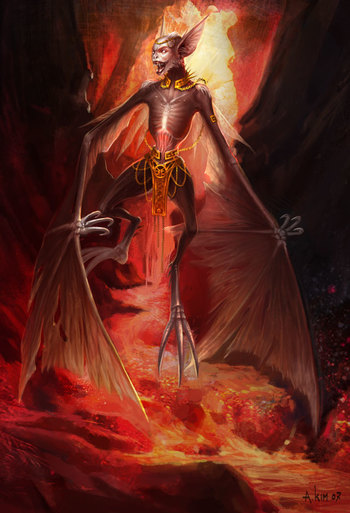
- Airborne Mook: Extremely common, always attack from above.
- Feathered Fiend: Though they are more annoying than outright dangerous.
- Harping on About Harpies: Some of them have wings and heads like bats instead of birds.
- National Geographic Nudity: They have exposed female breasts, but are generally designed to look like filthy, messy animals, giving them this effect.

- Art Evolution: The very first gorgons were emaciated with uniformly colored non-descriptive bodies and featureless faces. As the graphics improved, better and more variegated Gorgons appeared.
- Eye Beams: Their petrifying gaze attack is released as a colored beam of searing light from their eyes.
- Gorgeous Gorgon: Zigzagged, but mostly averted in that they're either gaunt (first two games) or snake-like (Ascension), but Chains, Ghost and III features much more attractive Gorgons known as Gorgon Serpents.
- Off with His Head!: Kratos' standard way to dispatch most Gorgons, except Cobra Gorgons (bisected head).
- Snake People: They have all reptilian's tails in lieu of legs, usually more and more detailed with each game.
Medusa
The Queen of the Gorgons whose gaze can turn mortals into stone.
- King Mook: Averted, she's unique compared to the other Gorgons and has a prettier design, but she's weaker than the Gorgon Assassins encountered later and, to rub salt into the wound, Gorgon Queens identical to Medusa appear later.
- Sadly Mythtaken: There were only 3 gorgons (all of them being sisters) in Greek Mythology, wheareas in God of War Medusa is one of their three Queens.
- Shout-Out: Her (and by proxy all of the other gorgons in the series) design is obviously based on her appearance in Clash of the Titans and its remake.
- Super-Speed: As expected from a snake-like creature, she moves very fast despite her size, her lack of legs and the terrain.
- Taken for Granite: And all the other Gorgons can do this.
Euryale
Medusa's older sister.
- Bilingual Bonus: Her battle theme has the words "platharee skila" which means "fat bitch" in Greek.
- Even Evil Has Loved Ones: The reason she wants to kill Kratos is because she blames him for the death of her children.
- Fat Bastard: She is a morbidly obese gorgon.
- Ground Pound: When grounded, one of her attacks consist in her advancing while pounding the ground in a rage.
- Mama Bear: When she calls Kratos a child killer, it's not about human children she is talking about, but her own brood.
- Motive Rant: Makes her a little sympathetic.Euryale: Kratos...murderer of children. I know this! I am aware of the misery you have brought upon my brood! ...Ruthlessly cutting down my line; your hands wear their blood. Praise to the Sisters! For on this day, Kratos... You will meet your end!
- Mighty Glacier: Unlike her smaller counterparts, she's very clumsy.
- Off with His Head!: She gets her head sawed off by Kratos.
- Set Right What Once Went Wrong: Went to The Sisters Of Fate to try to reverse Medusa and Stheno's deaths, or at least tried, but can't really move out of her temple in the Bog of the Forgotten.
- Super-Strength: Also doubles as Stout Strength since she is strong enough to pull stone pillars.
- Taken for Granite: As Medusa's sister, she can do this too.
Stheno
The largest of the three sisters and also the original Queen of the Gorgons.
- And I Must Scream: She is trapped in the Bog of the Forgotten and unable to get out.
- Attack of the 50-Foot Whatever: She's absolutely colossal, even compared to Euryale.
- Snake Person: Implied, though one of the artworks gives her a more crocodilian body with many small legs.
- Uncertain Doom: Its unknown what ultimately became of her given Medusa became Queen of the Gorgons, if Stheno died or if she is still trapped in the Bog.note
- The Unfought: Twice, since she is never faced by Kratos despite him visiting the Bog of the Forgotten in II, as she is only present in Ascension's multiplayer and even then she isn't fought by any of the warriors, being merely a hazard they must avoid.

- Breast Attack: Kratos can finish some of them by jamming his blades in their breasts before extending the chains and slamming them on the ground.
- Butter Face: They have very large busts with horrifyingly large mouths with sharp teeth.
- Cleavage Window: The desert sirens encountered in God of War wear underbust corsets hold by thin strips which only partially cover their nipples, effectively exposing almost entirely their large breasts. The other species of Sirens wear worn-out long dresses which entirely expose one or both of their breasts.
- Cruel and Unusual Death: Kratos kills some of the Sirens by grabbing them and then bending them backwards, breaking their spinal column. When a siren is killed in this way she emits a loud scream of pain which can damage surrounding foes.
- Glasgow Grin: Siren Sybils from Ascension look human, save for the gaping ear-to-ear mouth filled with teeth.
- Fan Disservice: Sirens are noted for being beautiful and certain variants such as Siren Widows, Sybils and Seductresses are noted to be topless. With that said, they have very monstrous faces.
- Femme Fatalons: Just like the Gorgons, they have very large hands and claws that are used for melee combat.
- Lamprey Mouth: Some Sirens have this as their only facial feature.
- Sadly Mythtaken: In Greek Mythology, Sirens were women with the bodies of birds whose beautiful singing encouraged sailors to crash their ships. In God of War, Sirens are man-eating Humanoid Abominations with Creepy Long Fingers who are first encountered in the desert.
- Super-Scream: Their primary form of attack are sonic screams. Siren Widows can even paralyze Kratos by unleashing a very deafening sound that will leave him vulnerable for other sirens to attack. When they are killed they also emit a sonic scream, which can be used by Kratos to damage surrounding foes.
- Stringy-Haired Ghost Girl: The most basic and human-looking sirens resembles this trope due to having their hair covering their entire face.

- An Arm and a Leg: Kratos kills them by ripping off their arm-blade and using it to behead them.
- Blade Below the Shoulder: All Wraiths have massive blades in lieu of hands, seemingly made of bone. A variant from the second game can throw the blades like boomerangs.
- Dig Attack: Their Signature Move; they sink into the ground and attack Kratos from below.
- Fragile Speedster: They're fast and move quickly by gliding above the ground or by sinking in the earth, but they're not sturdy.
- The Undead: Being wraiths, they have a spectral look and an empty lower body.
- Unique Enemy: While most of the Wraiths encountered in II have the exact same moveset in the first game, the final set of wraith enemies in the Courtyard of Atropos uses a far more deadly moveset and more resilient than the other wraiths normally encountered. It's the only time that they're encountered although they also appear in 2 of the Challnge of the Titan modes.
- Vengeful Ghost: In Valhalla Kratos recounts in his letters to Atreus that Wraiths are the angry spirits of those who went unburied, or were done so improperly, who take out their torment on the living.
- Weakened by the Light: In the third game Wraiths can be stunned by using the light of Helios.
- Elite Mooks: Fates' Guardians are stronger versions of regular Fates' Sentries which can be distinguished by their red armor and battleaxes.
- Giant Mook: Fates' Juggernauts are huge, armored brutes with Epic Flails and are much tougher than regular Servants.
- Our Demons Are Different: It's not clear exactly what they are supposed to be, but they resemble brutal, Satyr-like humanoids with dark skin and goat legs.
- Suspiciously Similar Substitute: To the Undead Legionnaires from the other games, which they temporarly supplant and occasionally fight alongside.
- Boss Tease: The Dark Rider shows up to harass Kratos on his way to Typhon's Lair. They get to fight for real on the way to the Island of Creation.
- King Mook: The Dark Rider, the strongest warrior and wielder of the Spear of Destiny, is a fully-fledged boss fight in comparison to the rest of the Servants just being bog-standard Mooks.
- High-Altitude Battle: Kratos has to fight him while riding on the back of Pegasus before jumping over to the Rider's flying mount to finish him off and steal his weapon.
- Purple Is Powerful: The Dark Rider has bright purple ornaments and wields a magic spear made of purple crystals.

- Apparently Human Merfolk: They are the inhabitants of Atlantis and possess aquatic features, even emerging from the seas to attack Kratos.
- In the Back: Their grab attack has them choking Kratos from behind with their polearms's rod. If Kratos runs out of health, they push him to the ground and impale him like a fish.
- Mooks: For a good part of Ghost of Sparta, they are replaced by a stronger variant, the Lords, when Kratos returns to Atlantis.
- Prongs of Poseidon: They're Atlantean merfolk who use tridents as weapons. The ranged variant uses throwing knives instead.

- Attack Its Weak Point: The Kraken seems to be impervious to damage, except for the bleeding sore on the forehead and the exposed patches of flesh on the front tentacles. Attacking the top one requires the use of Icarus' Wings.
- Colossus Climb: Downplayed, you still have to climb on the stuck tentacles to mutilate them.
- Combat Tentacles: Its main form of attack, they also act as his weak point. Two in the front and two in the back, tipped with shell-encrusted claws.
- Cruel and Unusual Death: Kratos makes it lose the grip on the columns and activates the bridge, which hits the Kraken in the mouth and smashes it against the opposite platform.
- Giant Space Flea from Nowhere: Where and how did it appear from? Who summoned it? We will never know for sure. According to the novelisation it was sent by Poseidon to kill Kratos, but this explanation is absent in-game.
- Kick the Dog: After losing his second tentacle to Kratos he picks up the Last Spartan's corpse (which Kratos was using to open the vents to reach his forehead) and messily devours it.
- Sadly Mythtaken: Kraken was a monster from Norse mythology, not Greek. It's most likely the developers wanted to add Ketos/Cetus (who was supposed to eat Andromeda and was killed by Perseus), but decided that a reference to the Clash of the Titans movies (which have become more famous) would be better.
- Shout-Out: To the simularly named creature from Clash of the Titans and its remake.
- Tentacled Terror: It looks like some kind of cephalopod.
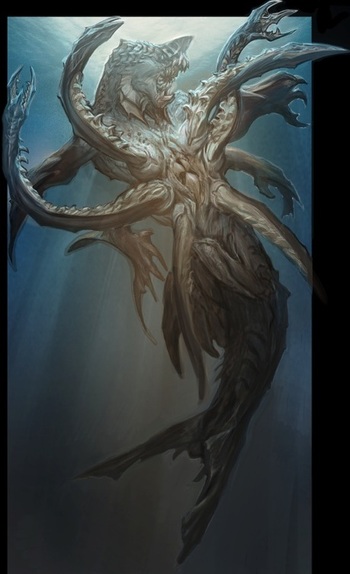
- Combat Tentacles: She has six tentacles emerging from her chest cavities.
- Cutscene Boss: Aside from the first introductory boss fight on the shore, all the other fights against Scylla are either a cutscene or a quick time event.
- The Determinator: Even after getting an eye gouged out by Kratos she still relentlessly pursues the Spartan across the city of Atlantis even through a volcano, needs to be scalded by magma to desist and only dies after getting an archimedean screw through the head.
- Mix-and-Match Critters: She looks rather shark-like, but also has several crab-like legs, a narwhal's horn, humanoid arms and squid-like tentacles.
- Multi-Armed and Dangerous: Has six tentacles sprouting from her abdomen as well as two arms.
- Nested Mouths: Scylla has a secondary set of mouth under her main one, which is visible everytime she screams.
- Sea Monster: She was summoned by Poseidon to safeguard the city of Atlantis.
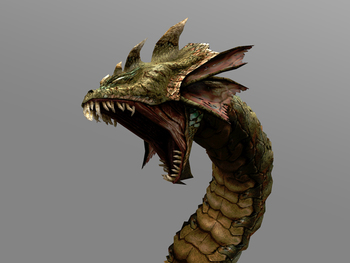
- Attack of the 50-Foot Whatever: The true head is gigantic, even compared to the standard ones, and given how it can simultaneously attack two vessels at once it's implied that the rest of the body is gargantuan.
- Eye Scream: How Kratos finishes off the first head, forcing it to withdraw.
- Hydra Problem: Averted, its head(s) don't grow back. Though to be fair, Kratos doesn't kill and burn them with fire. A mariner mentions that the giant one can heal the others.
- Impaled with Extreme Prejudice: How its 3 main heads are defeated.
- Law of Chromatic Superiority: Lesser heads are light blue, the true head is red.
- Multiple Head Case: You end up fighting no less than 5 heads, including the "mother one".
- Non-Malicious Monster: Kratos by the time of Valhalla remarks that it was just an animal, in contrast to Kratos's own malice.
- Sadly Mythtaken: This Hydra lives in the sea and is a descendant of the original Lernaean hydra, which was killed by Heracles (aka Hercules) in a swamp and was instead a single unique creature.
- Sea Monster: Was a swamp monster in the original myth.
- Warm-Up Boss: The first boss of the game and second enemy encountered, but it's pretty easy to kill.
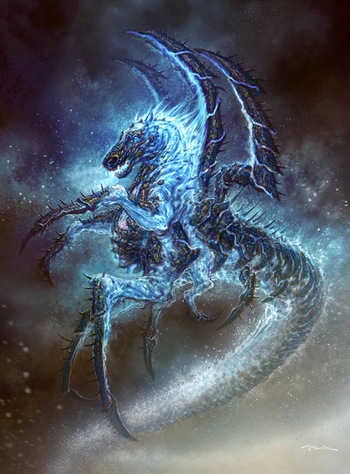
- Cool Horse: Well, they do belong to a god.
- Fusion Dance: As part of his One-Winged Angel transformation, they become a part of Poseidon himself.
- Making a Splash: Being the steeds of the Greek god of water and seas/oceans himself, this is a given.
- Mix-and-Match Critters: In addition to being horses with the tail of a fish, they also have crustacean limbs.
- Our Hippocamps Are Different: Hippocamps are heavily reimagined. They're composed in part of water and have crustacean stingers protruding from their bodies. As Poseidon's Right-Hand Attack Dogs, they make for several boss fights. To an extent, the hippocamps' unusual design is as it is because the original idea was that Poseidon would have leviathans as his trusted servants. These were turned into hippocamps to stay in-line with Classical Mythology, but some of the leviathan traits remained.

- Breath Weapon: They can breath fire, as well as barf out their puppies.
- Explosive Breeder: One of their attacks and the possible explanation why there's a whole bunch of them.
- Hell Hound: Based on the Trope Maker himself, Cerberus.
- A Kind of One: There were only a handful of such creatures in Greek myths. Here they are an entire separate race.
- Mook Maker: Adult Cerberi can spit out puppies, who will grow into more breeders if not killed fast enough.
- Multiple Head Case: Three heads, though they only start with one.
- Sadly Mythtaken: Plenty of the variants have some traits (horns, lack of eyes, zombie-like rotting flesh...) which the original didn't.
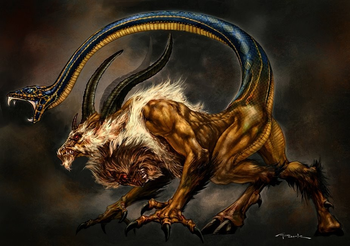
- Ascended to Carnivorism: The goat head is decidedly quite draconic-looking and sports a set of carnivorous-looking fangs.
- Breath Weapon: The ones encountered in God of War 3 breathe fire, while the white Chimera of Delphi in God of War: Ascencion spews ice instead. Both versions' snake tails spew paralyzing venom too.
- Bullfight Boss: The third phase with the goat head in control relies on ramming and dodging while jumping all around the arena.
- Classical Chimera: They retain the original Chimera's "Snake-goat-lion amalgam" design.
- Eye Scream: How Kratos kills the lion head, gouging out its eyes and driving his blades right through its skull.
- Four Legs Good, Two Legs Better: It can shift between biped and quadruped stance depending on which head is controlling it. When the snake and the goat are in control, the chimera walks on all fours with the lion facing down. When the lion is in control, it walks on two legs with the goat facing up.
- Impaled with Extreme Prejudice: Kratos kills the goat head (and finishes off the creature as a whole) by breaking off one of its horns and driving it right through the goat's eye socket and out its mouth.
- A Kind of One: There were only a handful of such creatures in Greek myths. Here they are an entire separate race.
- Mix-and-Match Critters: The most famous mythological example and possibly the Trope Maker.
- Multiple Head Case: Has the head of a lion, a goat and a snake.
 Word of God confirms that the lion and goat heads don't get along with each other very well. Depending on which head is in control, the Chimera's behavior changes, with the snake being a stalking ambush attacker, the lion being an aggressive melee close-range fighter and the goat being an evasive hit-and-run Bullfight Boss.
Word of God confirms that the lion and goat heads don't get along with each other very well. Depending on which head is in control, the Chimera's behavior changes, with the snake being a stalking ambush attacker, the lion being an aggressive melee close-range fighter and the goat being an evasive hit-and-run Bullfight Boss. - Off with His Head!: Or tail, actually, Kratos kills the snake tail by severing its head completely off the body
- Unique Enemy: In Ascension, they're encountered exactly once near the entrance to the Tower of Delphi, the same arena where a Manticore will be fought later on.

- Airborne Mook: Only for the part of the game spent on Pegasus.
- Beware My Stinger Tail: They have a hooked blade on the end of their tail for some reason.
- Mix-and-Match Critters: Part eagle, part lion.
- Our Gryphons Are Different: They're modeled after either an Opinicus or a Hieracosphinx.
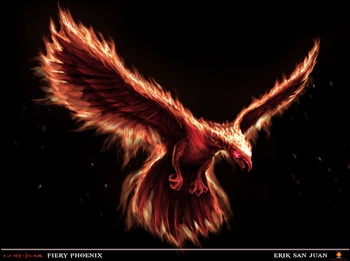
- Back from the Dead: A whole puzzle is dedicated to Kratos finding a way in bringing it back to life.
- Noble Bird of Prey: Or at least neutral seeing as it allows Kratos to summon and ride it.
- The Phoenix: Well duh. It's a flying bird made of flames that requires fire to be reborn.
- Wreathed in Flames: Being a phoenix, this is a given.

- Always a Bigger Fish: It introduces itself by killing and eating a Cyclops.
- Basilisk and Cockatrice: It's a giant reptile based on the former, although it lacks the petrifying gaze or deadly poison.
- Beast of Battle: The Persian King and Empire's strongest weapon against Greece.
- Breath Weapon: Can attack by breathing fire, and it's defeated when Kratos forces its mouth shut as it was about to exhale.
- Dinosaurs Are Dragons: It resembles a Spinosaurus or a Dimetrodon.
- Sadly Mythtaken: It's basically a giant mindless beast that can breathe fire, while originally it was a normal-sized snake or lizard which was so poisonous, it caused the very earth on which it walked to turn into a desert, was extremely cunning and could instantly kill anything except a weasel with its mere sight.

- Crossover Cosmology: A creature from ancient Persian and medieval Arabian myths showing up in a setting based on ancient Greek mythology.
- Feathered Fiend: They are controlled by the barbarian king Arlik.
- Giant Flyer: Though smaller than its mytholocial counterparts, which were said to be big enough to carry an adult African elephant.
- Roc Birds: They're essentially giant eagles, although they don't reach the sizes of their mythical counterparts.
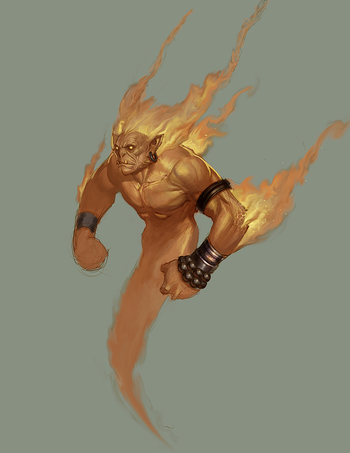
- Crossover Cosmology: Efreeti are fire spirits from Arabic folklore, and have nothing to do with Greek mythology.
- Genie in a Bottle: Averted since it's summoned instantly via spell. While it doesn't grant wishes, it does aid whoever commands it in battle.
- Ground Pound: When summoned it punches the ground causing a fiery explosion in a large radius. Upgrading it makes it continue to pound the floor and set more enemies ablaze, with the final upgrade making it end in a massive explosion.
- Our Genies Are Different: Ifrit are the Evil Counterpart Race to the Djinn and are known to play tricks on humans. This one doesn't have much personality though, seeing as it's used as a weapon.
- Playing with Fire: Its main form of offense.
- Sadly Mythtaken: They are from medieval Islamic Arabia, not ancient Zoroastrian Persia. Although considering that the Persian empire conquered parts of Arabia, it's plausible that the Persian King acquired it there.
- Summon Magic: How the Persian King (and later you) controls it.

- Adaptation Name Change: They were supposed to be called "elephantaurs" or "berserkers", until it was decided that the names didn't fit.
- Beast Man: They resemble humanoid elephants or the Hindu God Ganesha.
- Cruel Elephant: They're vicious creatures that will gladly kill you.
- Cruel and Unusual Death: Kratos finishes them off by stabbing his blade into their cranium and use the leverage to crack their skulls open, exposing the brains.
- Mighty Glacier: As expected, they are slow but incredibly strong.
- Sadly Mythtaken: In actual Hindu Mythology, the Juggernaut is a massive chariot with crushing wheels carrying a shrine with the bones of the avatar Krishna. These Juggernauts, if they are comparable to any Hindu gods, look more like Ganesh.

- Breath Weapon: They breathe fire.
- Our Sphinxes Are Different: Sphinxes resembling nothing so much as fire-breathing, winged saber-toothed cats appear as bestial enemies. Statues scattered here and there depict the more traditional woman-headed version.
- Panthera Awesome: They resemble saber-toothed cats.
- Prehistoric Animal Analogue: With their giant fangs and being much more feline than their mythological counterparts, they seem to be inspired by saber-toothed cats, such as Smilodon.
- Sadly Mythtaken: Sphinxes were lions with the head and chest of a human (mostly female) with feathered wings. These almost don't look the part. Strangely, concept art and some statues in the games do depict them accurately.
- Underground Monkey: They are basically reskinned versions of the Morpheus Beasts faced much earlier in the game, although made of flesh and blood, and not wreathed in fog.

- Crossover Cosmology: Manticores are from Persian, Arabian and Hindu mythology.
- Breath Weapon: They breathe fire.
- Expy: The final design used in the game looks like a Darker and Edgier version of the manticores (inaccurately called "wyverns") of World of Warcraft.
- Impaled with Extreme Prejudice: Kratos slays one by forcibly dragging the stinger down on the monster's head.
- Mix-and-Match Critters: Has the body, head and limbs of a lion, the mouth and teeth of a shark, the tail of a scorpion and wings (either those of a bird or a bat, like in this game).
- Our Manticores Are Spinier: They appear as giant, scorpion-like winged lions with a shark's mouth.
- Sadly Mythtaken: Manticores were colored red (not purple like here), had a human face, a voice sounding like a trumpet, left no remains from their victims and two pairs of limbs instead of one (excluding the wings).
Others
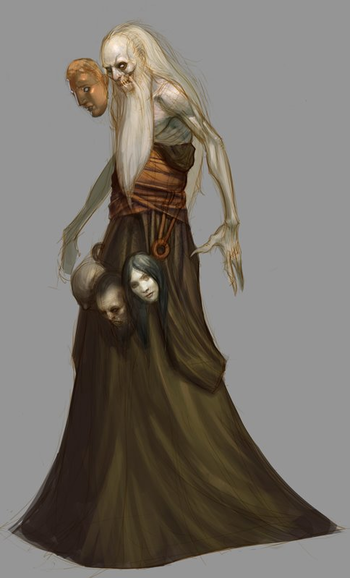
A being who ferries the souls of the dead to the Underworld.
- Cool Mask: Resembles a screaming human face.
- Creepy Souvenir: Wears a trio of rotten heads across the lower part of his robe.
- Evil Laugh: And a quite creepy one too...
- Evil Sounds Deep: A wicked being with a surprisingly deep voice, considering how thin he is.
- Flash Step: In two cutscenes, he suddenly gets behind Kratos mid-sentence. He does this a few times during his boss battles.
- The Grim Reaper: Though his function is not to kill, but to bring souls.
- Half the Man He Used to Be: Kratos bisects him with his own scythe. It doesn't take.
- Hoist by His Own Petard: He kills Kratos, but Kratos finds a weapon that can actually harm him in The Underworld.
- Hopeless Boss Fight: It doesn't matter how well Kratos does against Charon in their initial battle. Once he reaches half health, Charon will warp out of reach to atop the upper part of the ship and restore his health to full with the energy emitted from three pillars below on deck. He will then channel an unavoidable blast of flames from these pillars that will instantly defeat Kratos... that is until Kratos finds a new weapon and approaches the ferryman for a rematch.
- Humanoid Abomination: It's vaguely implied that he might have been mortal like Kratos since they mention they are alike when the gods will never let them in peace. But he is definitely so much more than mortal when you face him.
- Implacable Man: He keeps attacking even after Kratos cuts him in half. It takes getting his head smashed by the Gauntlet of Zeus repeatedly for him to finally die.
- It Is Not Your Time: Invokes this when Kratos tries to enter The Underworld while still alive. Of course, this just pisses Kratos off and they fight. And then he kills Kratos. Well, guess that was his time now.
- Muscles Are Meaningless: He's skeletal, but he's strong enough to go toe-to-toe with Kratos.
- Neck Lift: Does this to Kratos.
- "Not So Different" Remark: It's kind of prophetic, since he appears in a prequel, where Kratos doesn't know it yet.Charon: We share a common fate, Kratos. The gods will release neither of us from our torture.
- One-Hit Kill: Whenever he's done messing around, Charon will take to the upper part of his ship and launch a fiery shockwave of green energy that can't be blocked or evaded in any way, instantly draining Kratos' health to zero (and it heals him to boot). But once Kratos locates and arms himself with the Gauntlet of Zeus, he can use it to break the three pillars acting as conduits for the attack, depriving Charon of his strongest move and making the odds more even.
- Shadow Walker: Can melt into a puddle of darkness and slip away to reappear somewhere else during battle.
- Sinister Scythe: As the Grim Reaper, that is almost obligatory.
- Technicolor Fire: Most of his attacks utilize green flames.

Charged with guarding the gates to Pandora's Temple, he was the very first individual to try to take Pandora's Box, and the first to die, as punishment, he was condemned by the gods to forever burn the bodies of all those who have died in the temple.
- Age Without Youth: His body looks horribly decayed even though he has been immortal for ages now.
- And I Must Scream: He was cursed by the gods to guard the gates of Pandora and burn the bodies of those that died inside for centuries. Looking like a rotting corpse.
- An Arm and a Leg: Is missing his right hand and part of his right arm. With a piece of exposed bone sticking out to function as a Hook Hand.
- The Cynic: He sounds as jaded as someone who has a crappy job like his and has to open the gates for more and more foolhardy heroes trying to get inside the Temple so they could die horribly.
- Deadpan Snarker: The sarcasm on his voice when he wishes "May the Gods grant you strength to conquer the perils that lay before you" to Kratos is palpable.
- No Name Given: His name is lost to the ages.
- Uncertain Doom: It's unknown what happened to him after Kratos took Pandora's Box from the temple, but if he wasn't free of his curse after Kratos took the Box, then he presumably died when Pandora's Temple was destroyed in Tartarus with Cronos' death.

The first woman to ever come into existence, she was created by Hephaestus to act as the key to Pandora's Box.
- Artificial Human: A statue that Hephaestus crafted and breathed life into.
- Damsel in Distress: She requires being saved by Kratos by death traps like hanging blades or a water-filling tank. Otherwise, she manages to stay out of trouble during encounters with monsters.
- Face Death with Dignity: Pandora knows Kratos is after her because she is the only one that can extinguish the Flame of Olympus, which would mean her death. She accepts her fate since it means releasing Hope from the Box and give Kratos the power to kill Zeus.
- It Was with You All Along: At the end of Ragnarok Kratos becomes the God of Hope, which Pandora stated was in him all along. It may have taken a few centuries, but Pandora was right. In the end, Kratos was worthy of being a God - the issue is he was the wrong God at the time of the other games: The God of War, instead of the God of Hope.
- Leitmotif: "Pandora's Melody", a melancholic song that plays during the first Underworld segments and during Pandora's presence.
- MacGuffin Super-Person: Only she can unlock the Flames of Olympus.
- Mad Scientist's Beautiful Daughter: In a way. She is a construct created by the smith god Hephaestus and was intended to be nothing more than a key to the Flame of Olympus, but he came to genuinely love her like she was his own child.
- Morality Chain: Thanks to her, Kratos began to develop empathy for his fellow man and remorse for the things he had done, and not just the murder of his family. Mankind had use of it later when Kratos gave them the power of hope by killing himself.
- Older Than They Look: She resents being called a child.
- Plucky Girl: She can't fight, but she knows how to stay out of trouble and helps Kratos in certain puzzles he can't solve by himself.
- Replacement Goldfish: For Calliope.
- Senseless Sacrifice: Hope was inside Kratos the entire time.
- Too Good for This Sinful Earth: Of course a person that treats Kratos with respect will die.
- What Measure Is a Non-Human?: The Gods treat her like crap and they call her "it". This later becomes Kratos' Berserk Button. It's one of the reasons why Kratos respect Hephaestus so much - he only ever refers to her as his "daughter", never an "it", showing how much he truly cares for her.
- Wide-Eyed Idealist: Refuses to lose hope in a world that's being torn apart.Pandora: Hope is what keeps us strong. It is why we are here. It is what we fight with when all else is lost.
- You Remind Me of X: She reminds Kratos of his own daughter Calliope, mistaking Pandora for her when he first hears her voice.
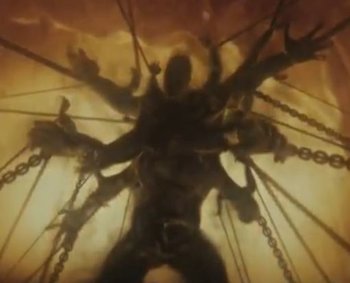
One of the Hecatonchires, or one hundred-armed giants. Having once sworn a blood oath to Zeus and then betrayed him, the Furies hunted him down and transformed his body into a living prison for those who followed his example.
- And I Must Scream: Holy mother of God. For starters, when he broke his oath to Zeus, the Furies hunted him down and put him through the mother of all Fates Worse than Death: having his body petrified and hollowed out and turned into a giant prison for those who followed his example. And then Megaera uses her parasites to infest different parts of his body and turn them into monsters to fight Kratos. Judging by the way his eyes are moving when Megaera infests his head, he's still alive and fully conscious through it all.
- Auto Cannibalism: You end up forcing him to bite down on his own mutated arm.
- Body Horror: Where do we start? First off, his entire body was petrified, hollowed out and then converted into the Prison of the Damned. To top it all off, while fighting Kratos, Megaera uses her Puppeteer Parasites to infest two of his arms, as well as his face, converting them into giant bug monsters under her control.
- Dub Name Change: In the Italian dub, his alternate name "Bryareus" is used instead, as well as "Centimane" (lit. Hundred-Handed, the Italian name for Hecatonchires).
- Multi-Armed and Dangerous: He has one hundred arms.
- Womb Level: Most of Ascension takes place in and around his body.
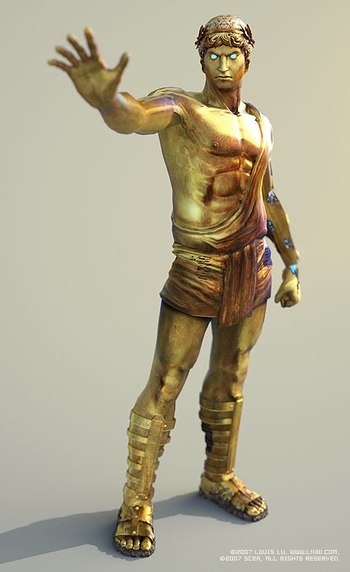
One of the 7 wonders of the ancient world, a giant statue of the sun god Helios brought to life.
- An Arm and a Leg: Kratos manages to sever its left hand during the second stage.
- Attack of the 50-Foot Whatever: Hell yes.
- Clipped-Wing Angel: After Kratos uses the Blade of Olympus to harm him by inflicting an open wound in its side, its the Colossus' turn to be vulnerable and he leans over the platform using only its stump-cannon to drive Kratos back.
- Colossus Climb: Though he can only be climbed during the quick-time event sequences.
- Eye Scream: Kratos stabs out its right eye during the first part of their boss fight.
- The Juggernaut: Though Kratos manages to rough up the Colossus pretty bad during their encounters, the Colossus still keeps coming back as long as Kratos' divine energy is used to fuel it. The only way to beat it is to use the Blade of Olympus to drain the energy back.
- Light Is Not Good: Its a statue of Helios, God of the Sun, with some gold/bronze painting and electric-blue energy emanating from within. It will also kill anything on its path to get to Kratos.
- Living Statue: It was brought to life after Zeus stole Kratos' divine power and granted it to him.
- Small Role, Big Impact: It only appears at the beginning of God of War II, but Kratos is forced to drain his powers into the Blade of Olympus to destroy the Colossus, which then crushes him afterwards, leading to the rest of the game.
- Womb Level: During the final stage, Kratos must enter inside the Colossus to drain its energy using the Blade of Olympus.

A winged magical horse which helps Kratos reach the Island of Creation.
- Cool Horse: Possibly the Trope Codifier.
- Dark Is Not Evil: While it looks like a Hellish Horse, it's actually benevolent (or at least it doesn't mind being ridden).
- Hot Wings
- Power Up Mount
- Sadly Mythtaken: Pegasus was white in the original myth and didn't have flaming wings. Also he was born from the dead gorgon Medusa and was used by Bellerephron to kill Chimera.
- What Happened to the Mouse?: Its ultimate fate is left uncertain.
